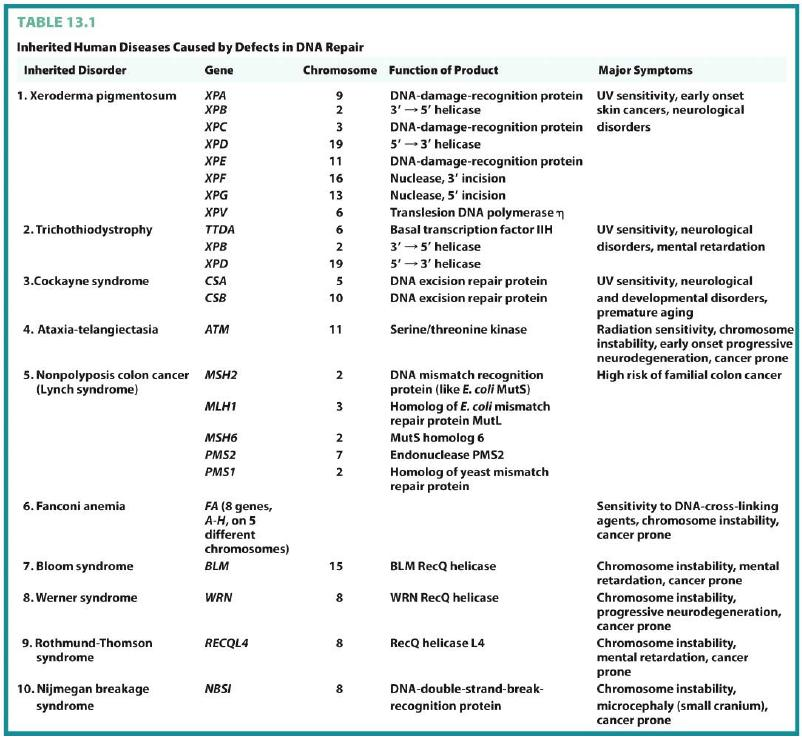L11 Mutation and DNA repair
一、Mutations
Introduction
The term mutation refers to a heritable change in the genetic material
Heritable: (可继承的、可转让的、可遗传的)指的是有能力遗传给下一代的细胞,而不是对个体而言
Mutations provide allelic variations
On the positive side, mutations are the foundation for evolutionary change needed for a species to adapt to changes in the environment
On the negative side, new mutations are much more likely to be harmful than beneficial to the individual and often are the cause of diseases
Understanding the molecular nature of mutations is a deeply compelling area of research.
Since mutations can be quite harmful, organisms have developed ways to repair damaged DNA
Mutation Types
Mutations can be divided into three main types
- Chromosome mutations
- Changes in chromosome structure
- Genome mutations
- Changes in chromosome number
- Gene mutations
- Relatively small change in DNA structure that affects a single gene
Chromosome Mutations And Genome Mutations
1. Alter Chromosome Structure
There are two primary ways in which the structure of chromosomes can be altered
- The total amount of genetic material in the chromosome can change:
- Deficiencies/Deletions
- Duplications
- The total amount of genetic material remains the same, but is rearranged
- Inversions
- Translocations
2. Alter Chromosome Number
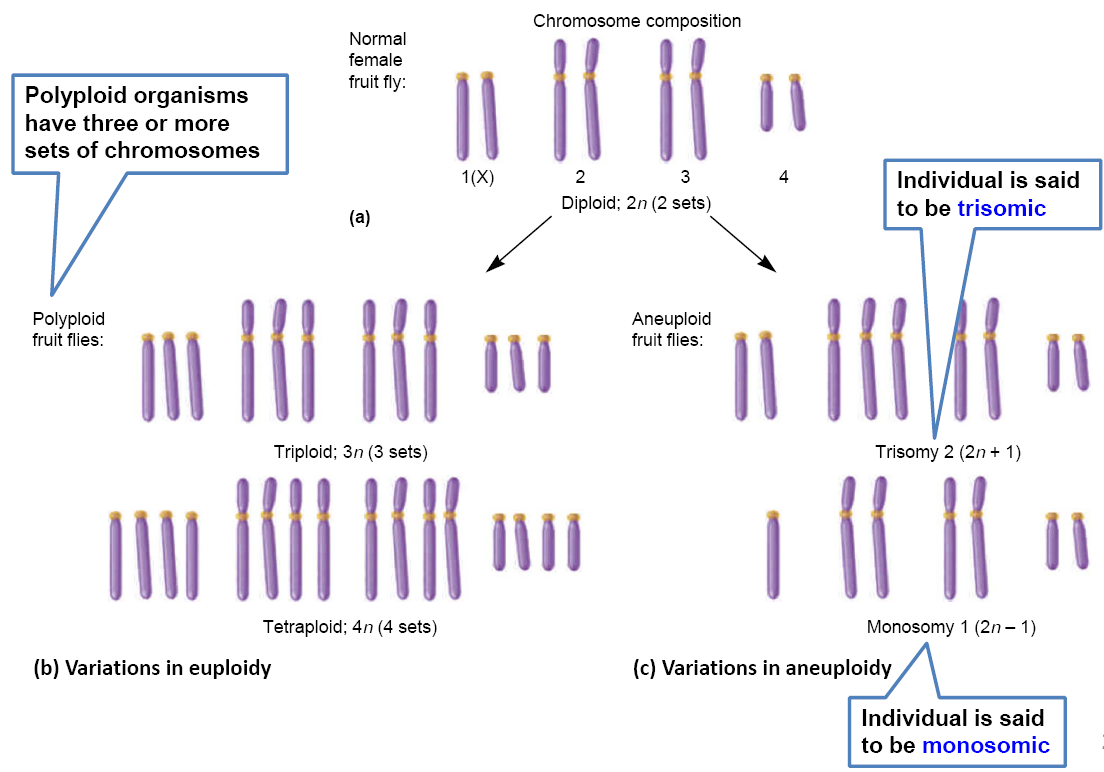
Gene Mutations
A point mutation is a change in a single base pair
- It can involve a base substitution

A transition((碱基)转换) is a change of a pyrimidine (C, T) to another pyrimidine or a purine (A, G) to another purine
A transversion((碱基)颠换) is a change of a pyrimidine to a purine or vice versa
- Transitions are more common than transversions(因为碱基配对的能量因素)
- Insertion
- Deletion
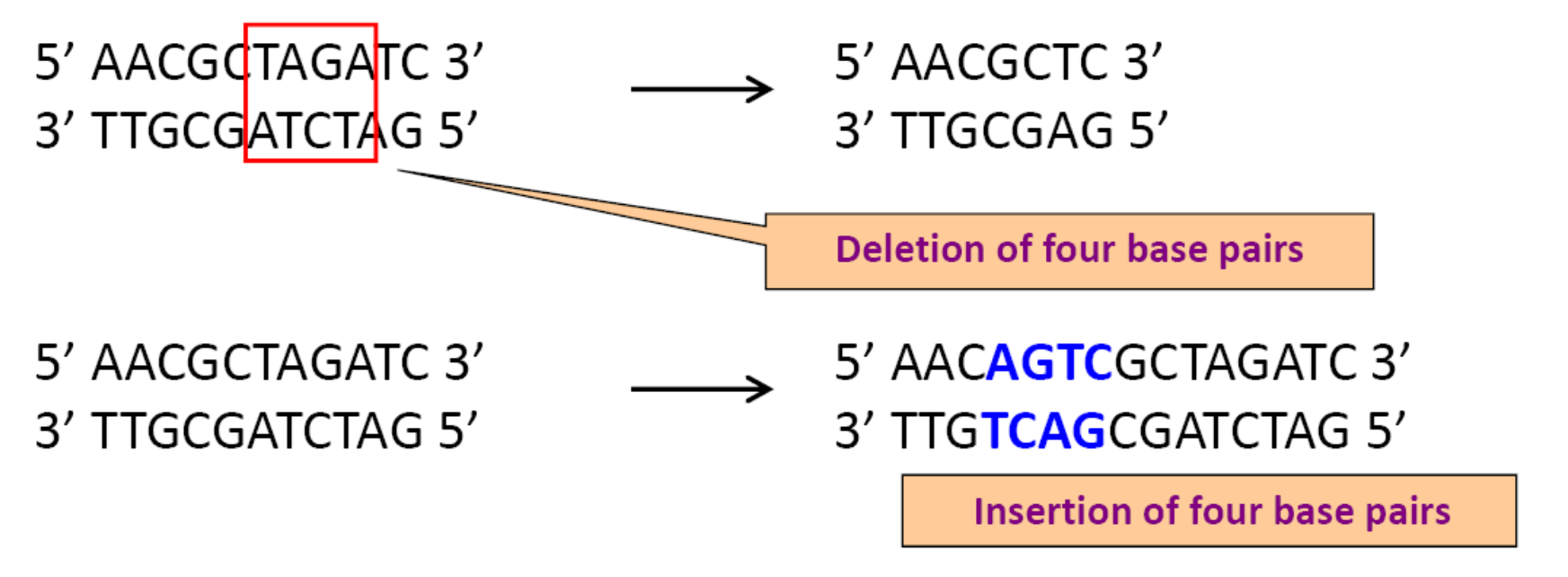
Mutation Effects
1. Point Mutation Effects
Mutations in the coding sequence of a structural gene can have various effects on the polypeptide
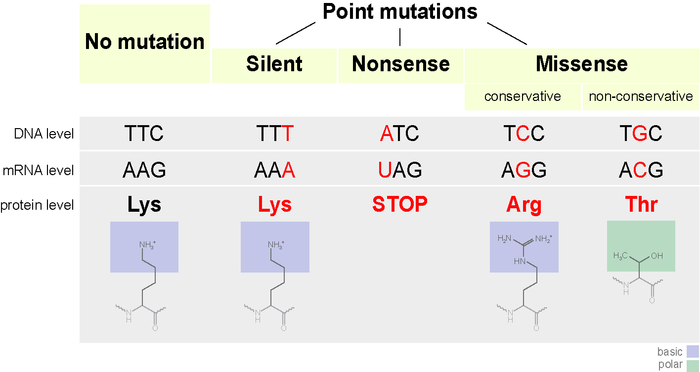
Point Mutations: Silent Mutation 静默突变
Silent mutations are those base substitutions that do not alter the amino acid sequence of the polypeptide
原因在于Due to the degeneracy(简并) of the genetic code
但是Silent Mutation可能引起蛋白质功能的变化:
- 由于静默突变可能改变密码子的偏好性,因此影响translation,从而影响protein folding的过程
Example:TTC → TTT
Point Mutations: Missense Mutations 错义突变
Missense mutations are those base substitutions in which an amino acid change does occur
- If the substituted amino acid has no detectable effect on protein function, the mutation is said to be neutral.
- This can occur if the new amino acid has similar chemistry to the amino acid it replaced
Example: Sickle-cell anemia:
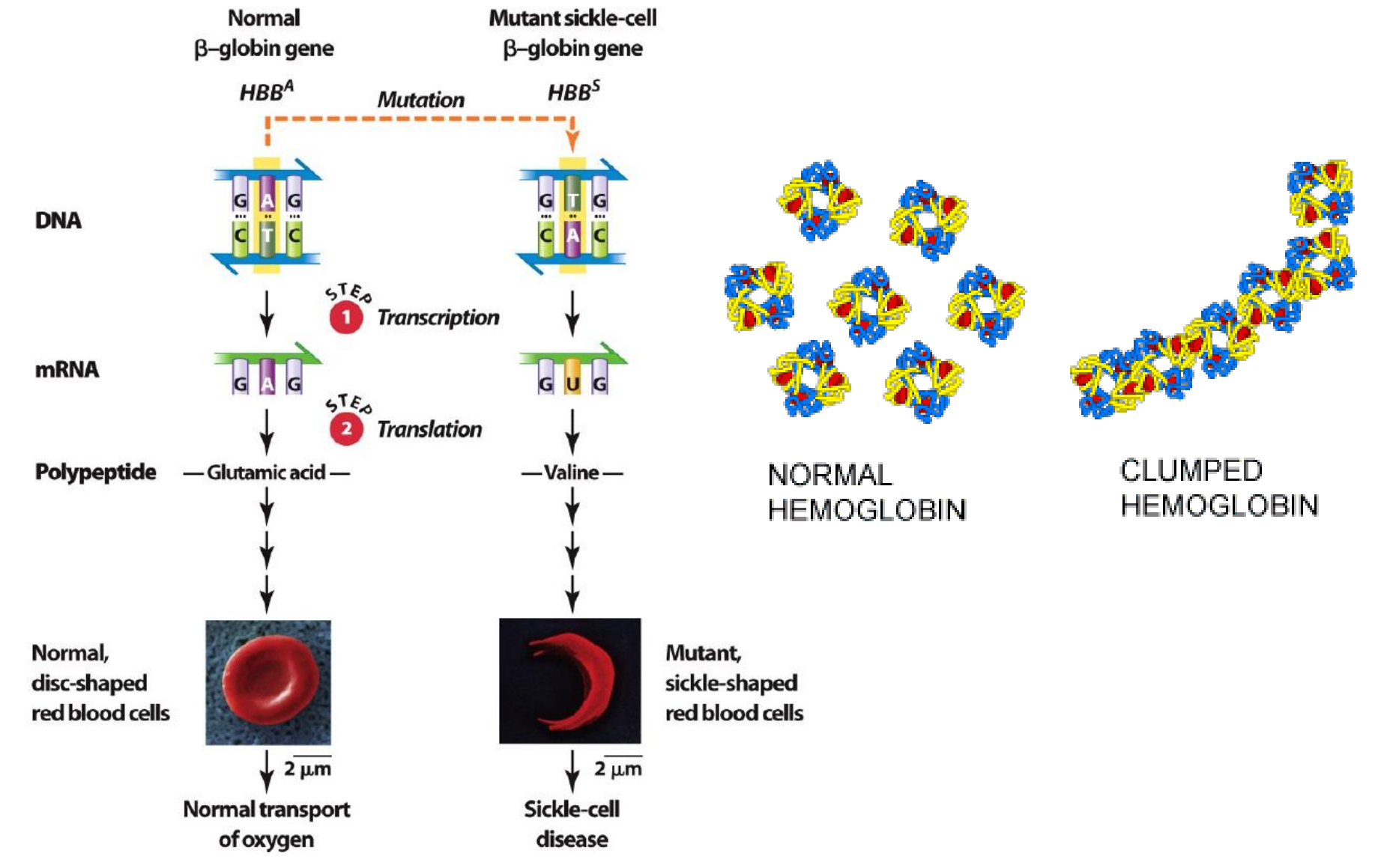
Point Mutations: Nonsense Mutations 无义突变
Nonsense mutations are those base substitutions that change a normal codon to a stop codon
Point Mutations: Frameshift Mutations 移码突变
Frameshift mutations involve the addition or deletion of a number of nucleotides that is not divisible by three
- This shifts the reading frame so that translation of the mRNA results in a completely different amino acid sequence downstream of the mutation
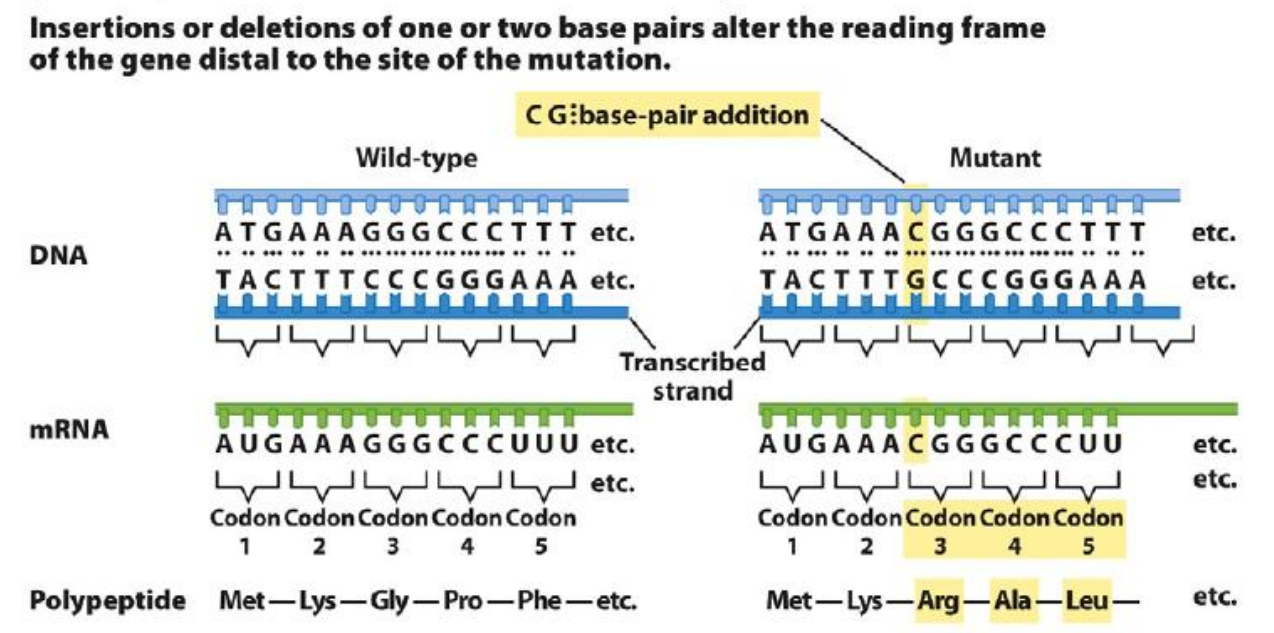
但是最终蛋白质的功能也可能不改变
Summary of Point Mutations
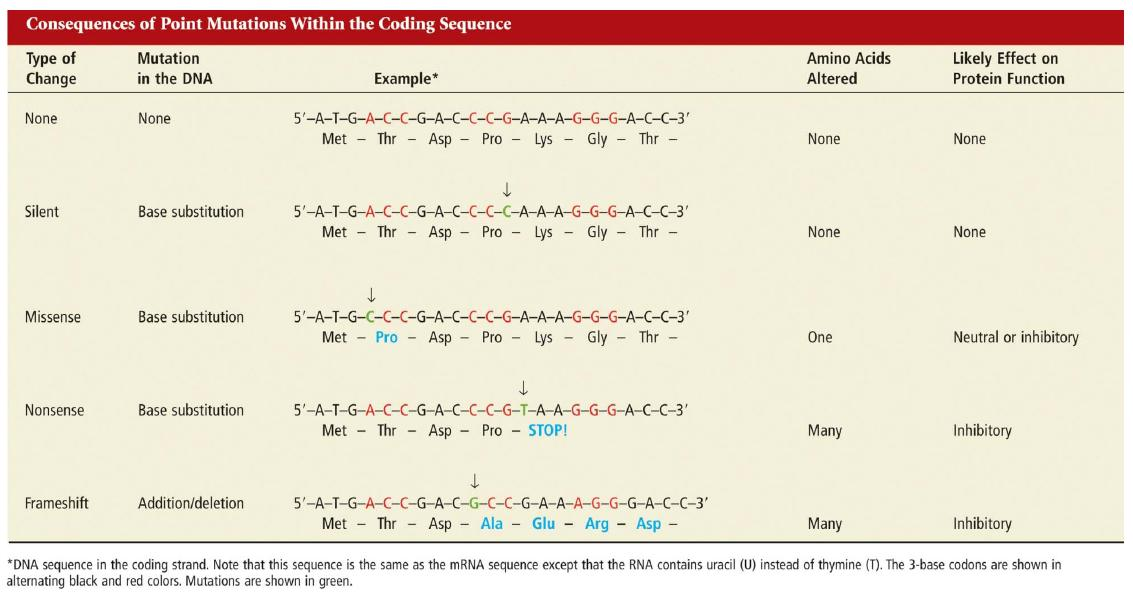
2. Mutation Effects on Genotype and Phenotype
Mutations can also be described based on their effects on the wild-type phenotype
They are often characterized by their differential ability to survive
- Deleterious mutations(有害突变) decrease the chances of survival
- The most extreme are lethal mutations(致死突变)
- Beneficial mutations enhance the survival or reproductive success of an organism
- The environment can affect whether a given mutation is deleterious or beneficial
Some mutations are conditional
- They affect the phenotype only under a defined set of conditions
- An example is a temperature-sensitive mutation
3. Gene Mutations outside of coding sequences
Gene Mutations outside of coding sequences can still affect phenotype
Mutations in the core promoter can change levels of gene expression
- Up mutations increase expression.
- Down mutations decrease expression
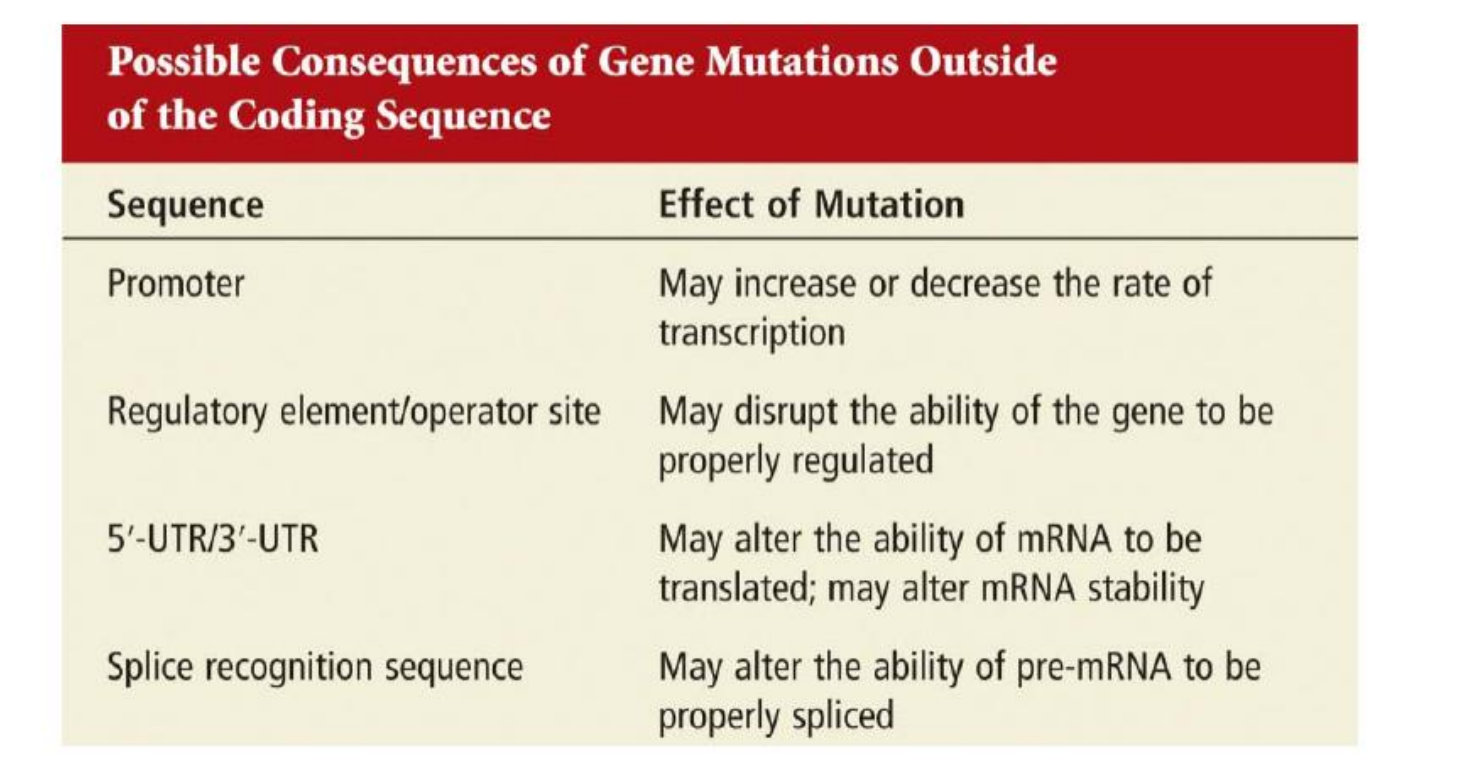
Different Mutation Locations
Geneticists classify animal cells into two types
- Germ-line cells
- Cells that give rise to gametes such as eggs and sperm
- Somatic cells
- All other cells
1. Occur in Germline 生殖细胞
Germ-line mutations are those that occur directly in a sperm or egg cell, or in one of their precursor cells
2. Occur in Somatic Cells 体细胞
Somatic mutations are those that occur directly in a body cell, or in one of its precursor cells
Somatic cell mutation may cause cancer.
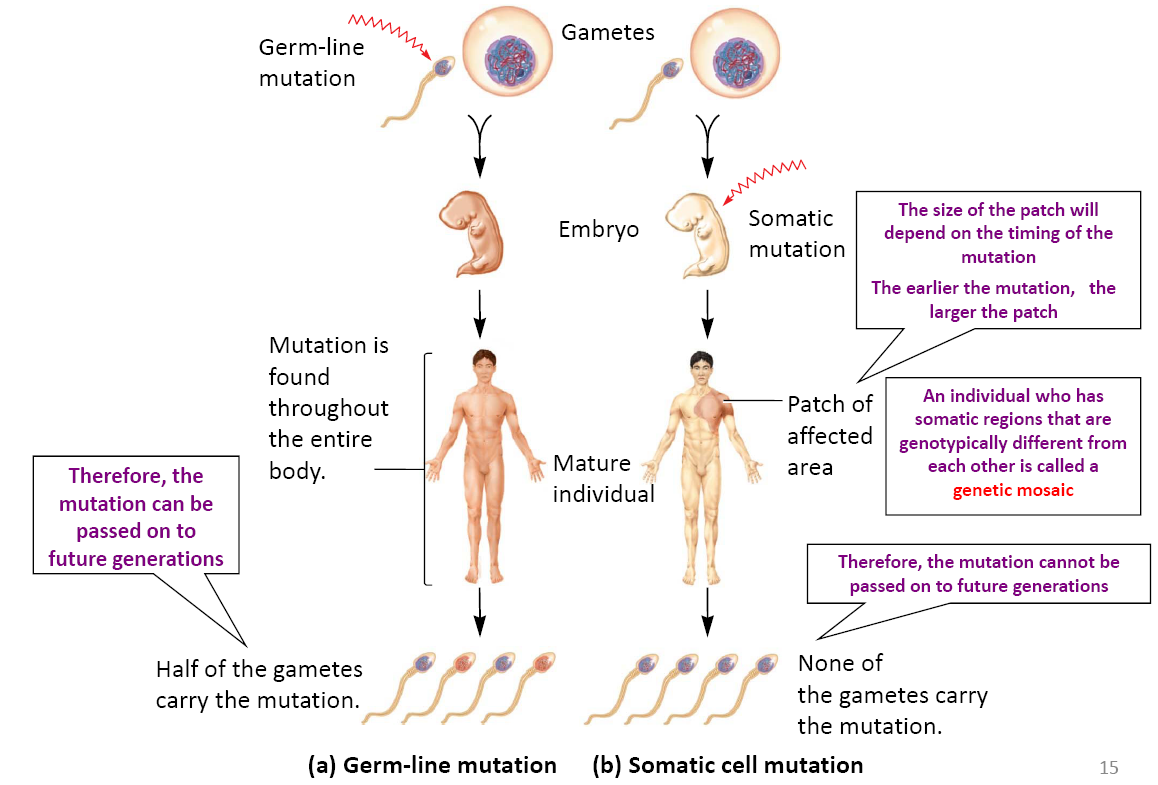
Occurrence and Causes of Mutation
Mutations can occur spontaneously or be induced
- **Spontaneous mutations **自发突变
Occur without a known cause due to inherent metabolic errors (abnormalities in cellular/biological processes ) or unknown agents in the environment.
- Errors in DNA replication
- **Induced mutations **诱发突变
Result from exposure organisms to mutagens, physical and chemical agents that cause changes in DNA, such as ionizing radiation, ultraviolet light, or certain chemicals.
1. Spontaneous Mutations
Spontaneous mutations can arise by three types of chemical changes
- Depurination 脱嘌呤作用 (most common)
- Deamination 脱氨作用
- Tautomeric shift 互变异构移位
Depurination
Depurination involves the removal of a purine (guanine or adenine) from the DNA
- The covalent bond between deoxyribose and a purine base is somewhat unstable
- It occasionally undergoes a spontaneous reaction with water that releases the base from the sugar
This is termed an apurinic site(AP 位点)
在生物化学和分子遗传学之中,AP位点(缺嘌呤/缺嘧啶位点),也被称作是缺碱基位点,通常位在由嘌呤或是嘧啶组成的DNA之内(也有极小机率出现在RNA之内),不是自发的话就是由DNA损伤造成。在一般生理条件下,估计每天约有10,000个缺嘌呤位点和500个缺嘧啶位点在一个细胞中产生。
AP位点能够由自发的去嘌呤作用产生,但也可能充当碱基切除修复机制中的中间产物。在这过程之中,DNA 糖苷酶识别受损的碱基,并切下N-糖苷键结,使碱基脱去产生AP位点。

Fortunately, apurinic sites can be repaired
- However, if the repair system fails, a mutation may result during subsequent rounds of DNA replication
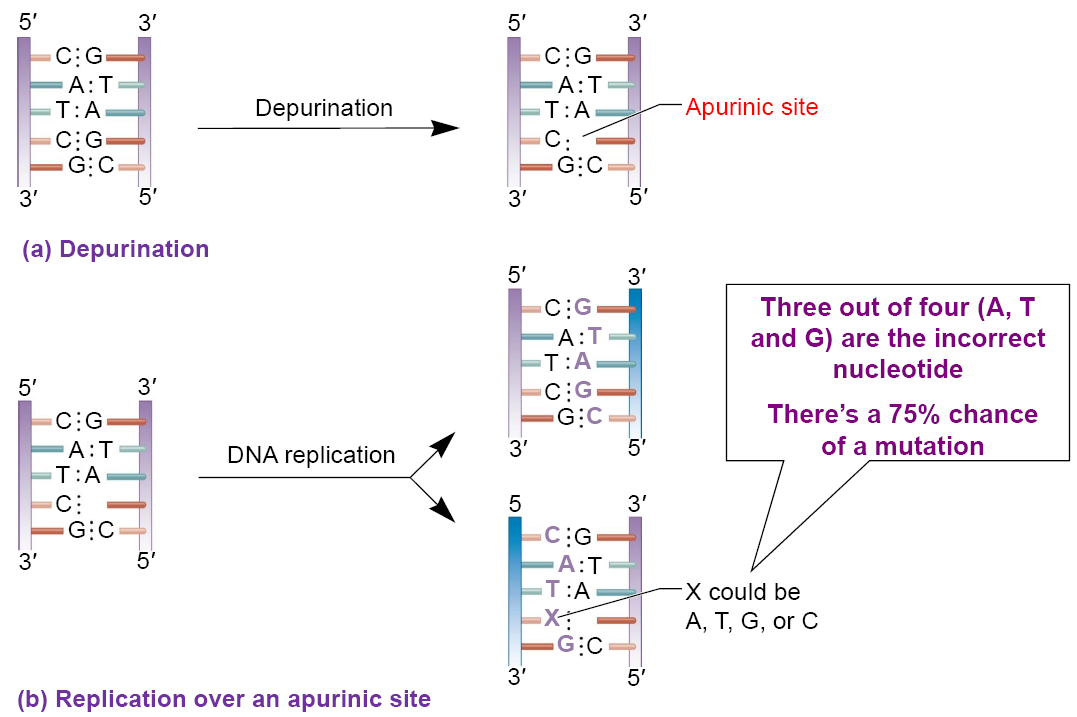
Deamination
Deamination involves the removal of an amino group from the cytosine base
- The other bases are not readily deaminated
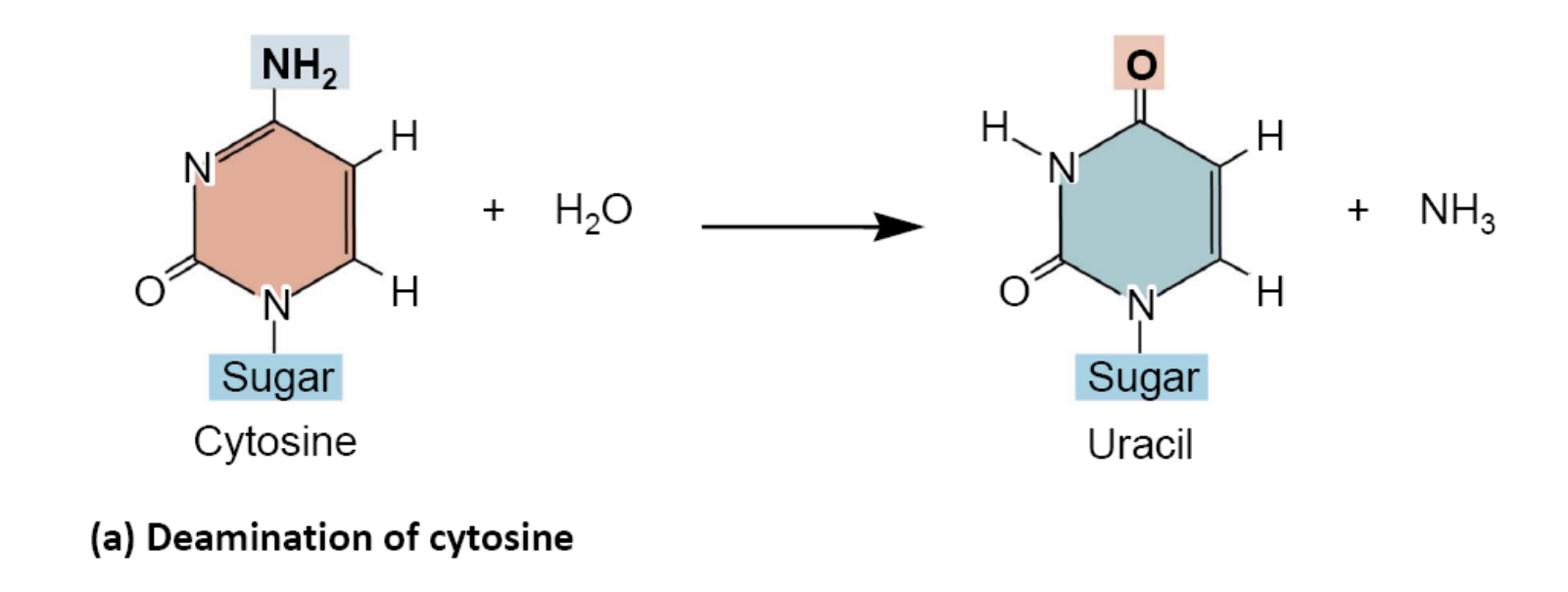
DNA repair enzymes can recognize uracil as an inappropriate base in DNA and remove it
However; if the repair system fails, a C-G to A-T mutation will result during subsequent rounds of DNA replication
Deamination of 5-methyl cytosine can also occur
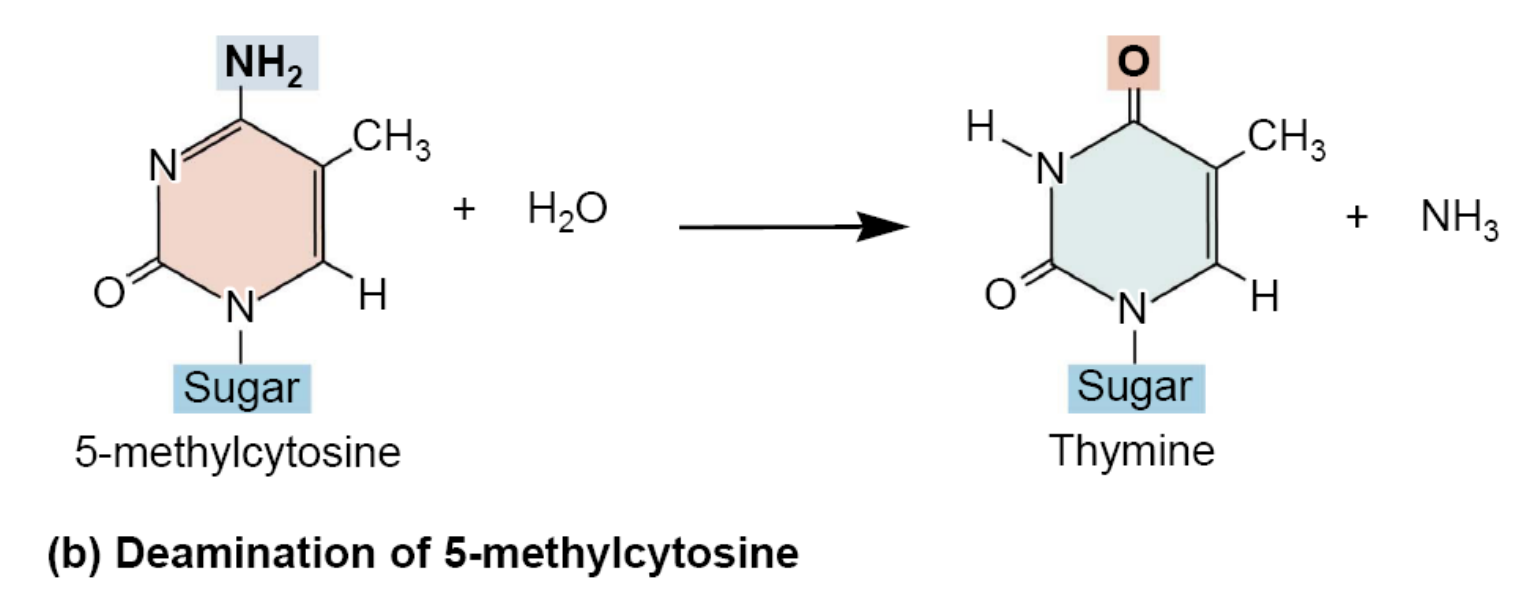
Thymine is a normal constituent of DNA
This poses a problem for repair enzymes
- They cannot determine which of the two bases on the two DNA strands is the incorrect base
For this reason, methylated cytosine bases tend to create hot spots for mutation
Tautomeric Shift
A tautomeric shift involves a temporary change in base structure
The common, stable form of thymine and guanine is the keto form(酮式)
At a low rate, T and G can interconvert to an enol form(烯醇式)
The common, stable form of adenine and cytosine is the amino form(氨基形式)
- At a low rate, A and C can interconvert to an imino form(亚氨基形式)
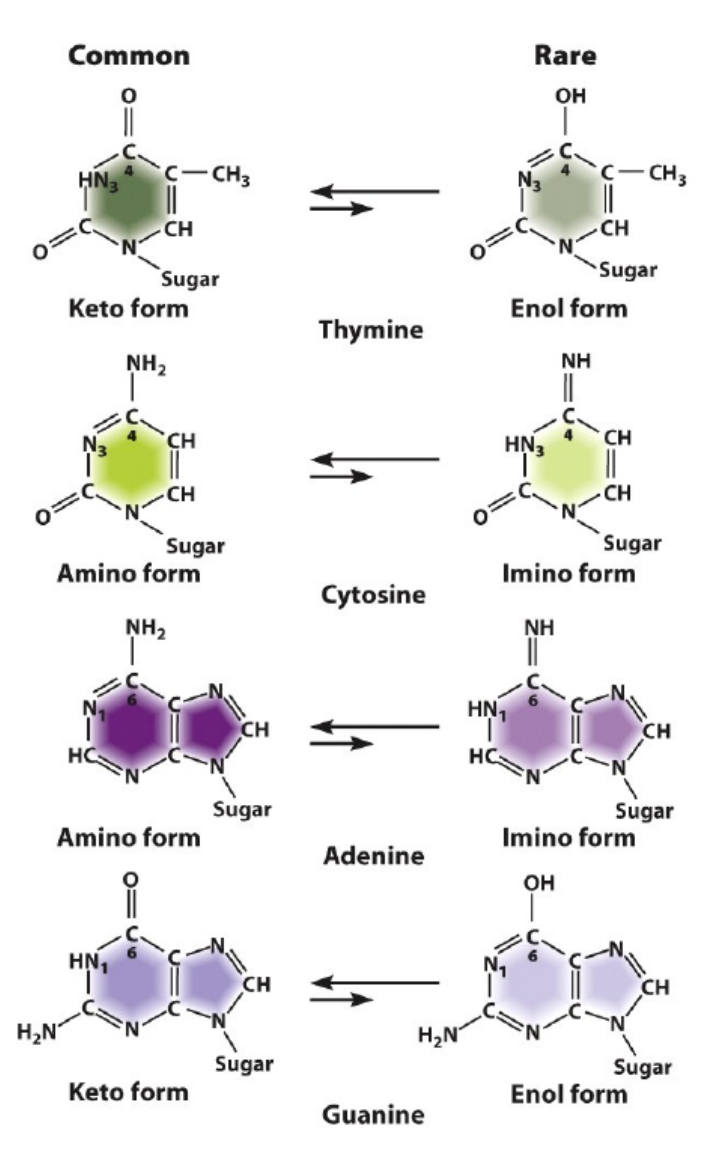
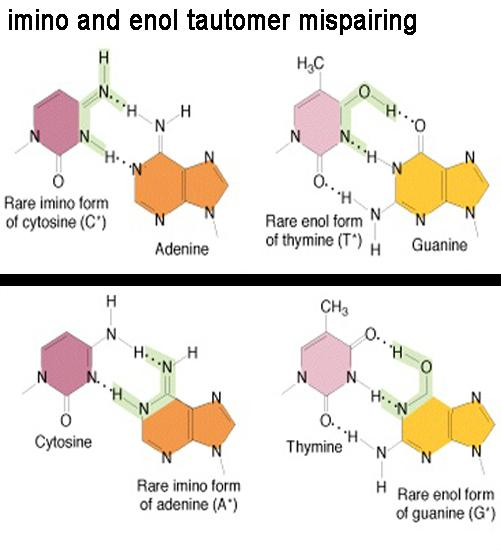
For a tautomeric shift to cause a mutation it must occur immediately prior to DNA replication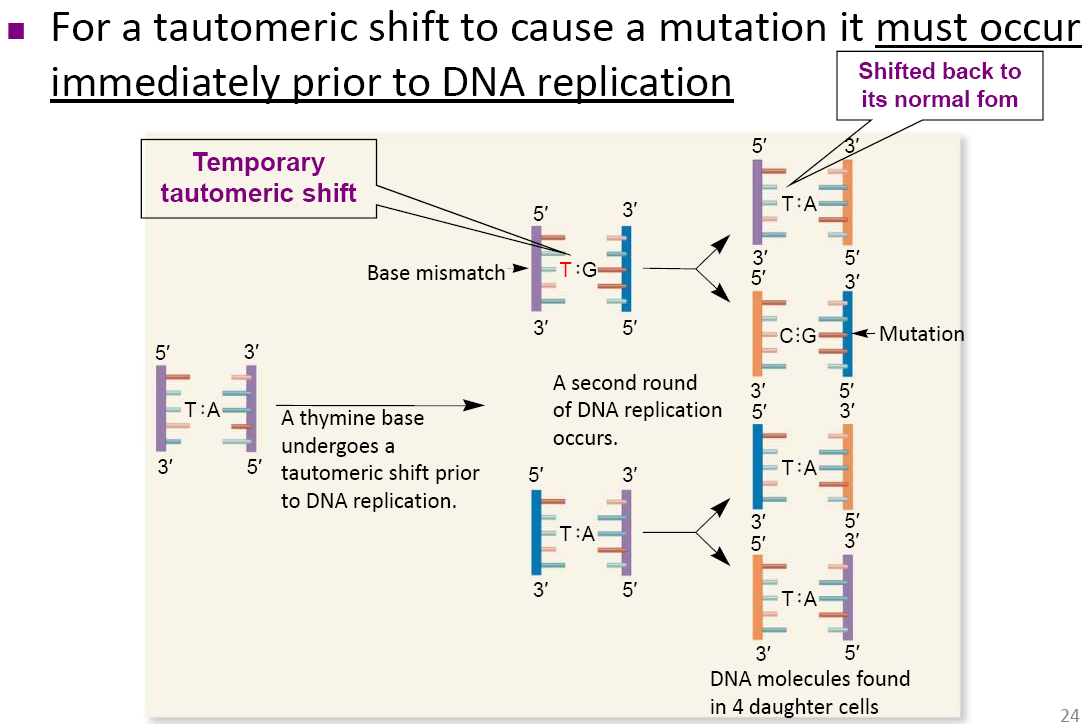
2. Types of Mutagens
An enormous array of agents can act as mutagens that permanently alter the structure of DNA
The public is concerned about mutagens for two main reasons:
Mutagens are often involved in the development of human cancers
Mutagens can cause gene mutations that may have harmful effects in future generations
Mutagenic agents are usually classified as chemical or physical mutagens
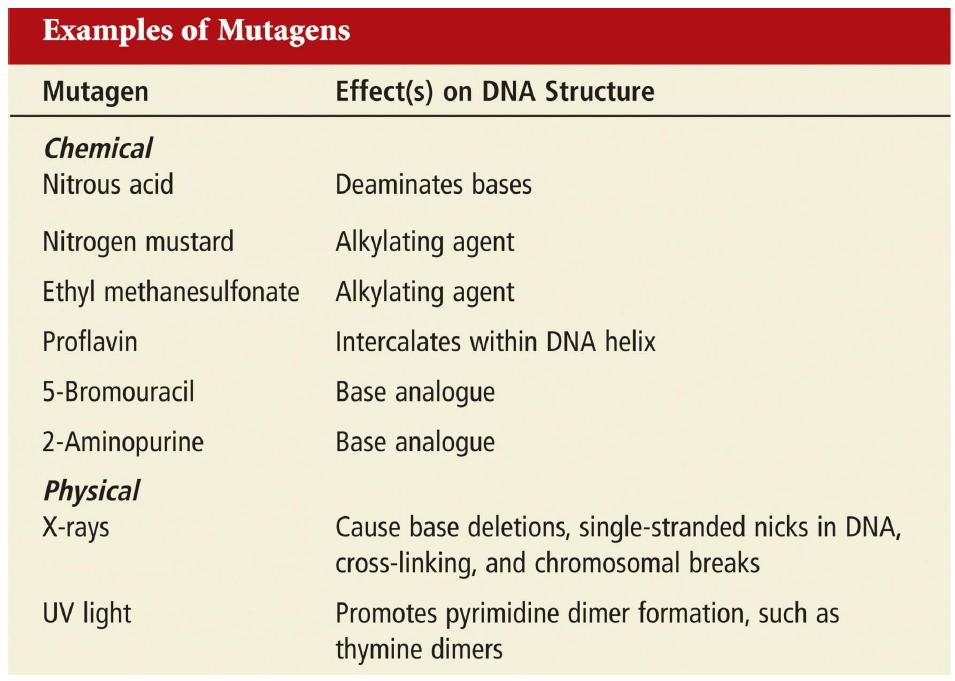
Chemical Mutagens Alter DNA Structure in Different Ways
Chemical Mutagens come into 3 main types:
- Base modifiers
- Intercalating agents 插入剂
- Base analogues

(1) Base Modifiers
Base modifiers covalently modify the structure of nucleotides.
- Deaminating agent 脱氨基剂
- Hydroxylating agent 羟基化剂
- Alkylating agent 烷化剂
Deaminating Agent
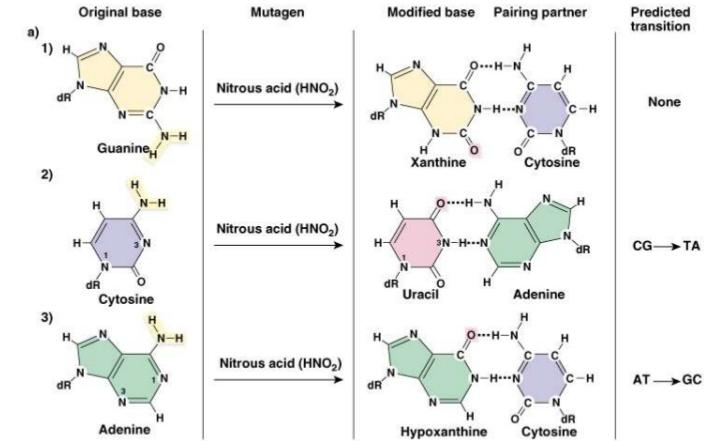
Example:
- Nitrous Acid 亚硝酸
Hydroxylating Agent

Example:
- Hydroxylamine 羟胺
Alkylating Agent
Alkylation - process
where electrophiles(亲电体):
亲电体(英语:Electrophile,意思为电子喜好者)为一化学术语,指在化学反应中对含有可成键电子对的原子或分子(亲核试剂)有亲和作用的原子或分子。
因为亲电试剂可以接受电子,所以它们是路易斯酸(见酸碱反应理论)。大多数亲电试剂为正电性,有一个原子带正电,或有一个原子不具备八隅体电子。
亲电试剂进攻亲核试剂上电子集中的部位。有机化学中常见的亲电子试剂有阳离子(如H 和 NO2)、极性分子(如氯化氢、卤代烃、酰卤,和羰基化合物)、可极化中电性分子(如Cl2 和 Br2)、氧化剂(如有机过氧酸)、不具备八隅体电子的试剂(如卡宾和自由基)、以及某些路易斯酸(如 BH3 和 DIBAL)。
- Attack negative centers
- Add carbon-containinggroups (alkyl groups 烷基基团)
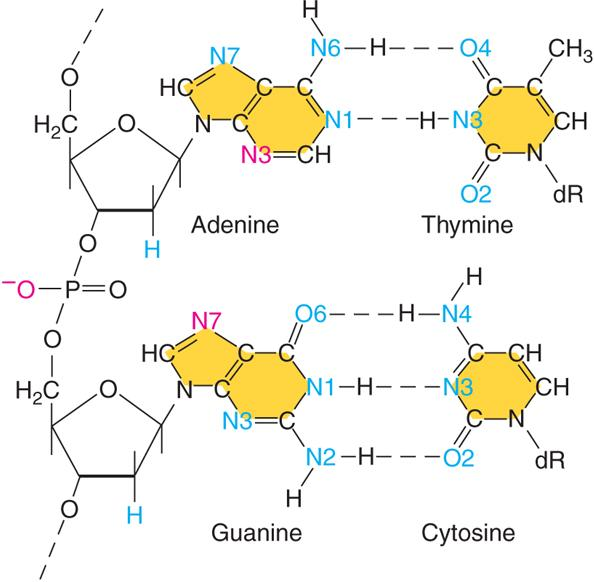
Common targets (red): N7 of G, N3 of A, phosphodiester bond O6 ofG
Some chemical mutagens disrupt the appropriate pairing between nucleotides by alkylating bases within the DNA
- Induce transitions, transversions, frameshifts, and chromosome aberrations.
- Examples: Nitrogen mustards and ethyl methanesulfonate (EMS)
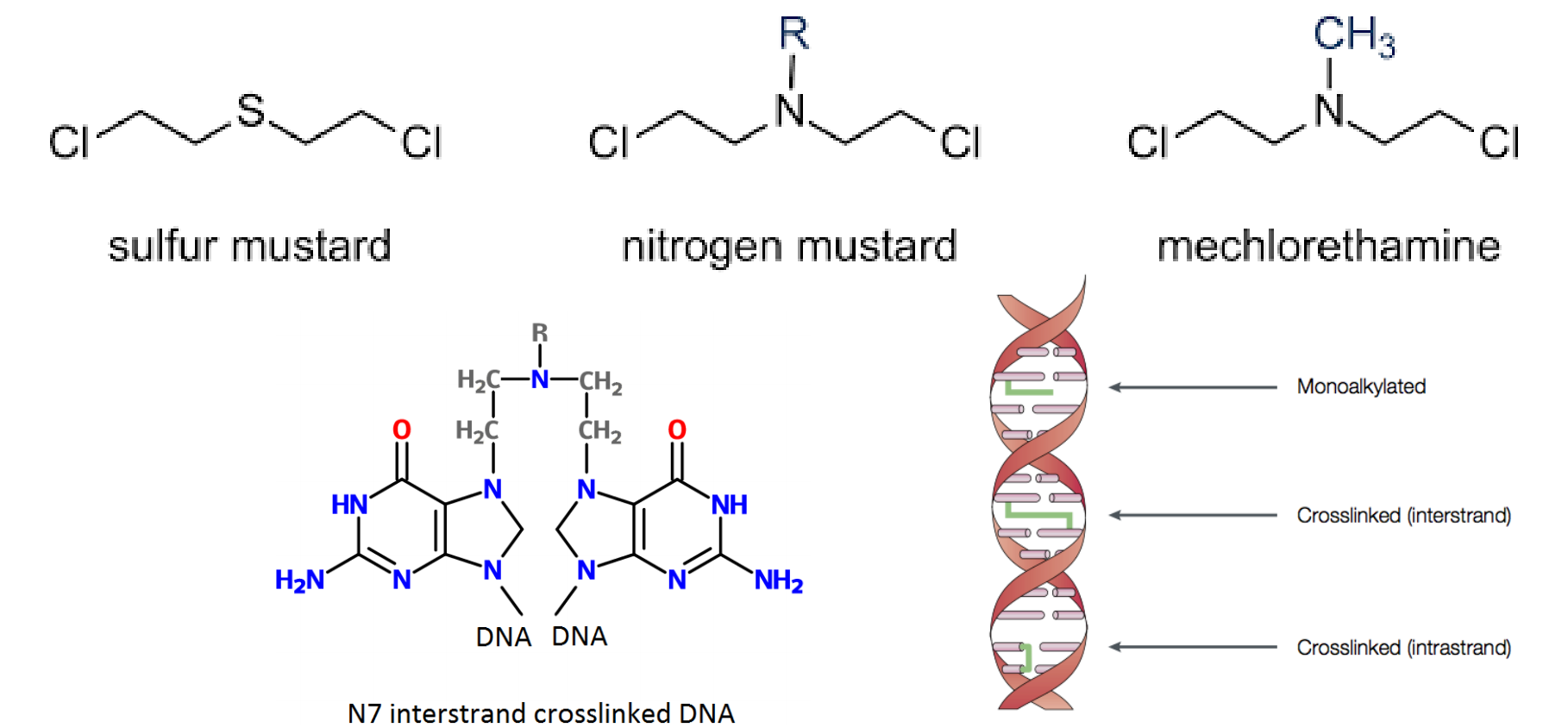
(2) Intercalating Agent
Intercalating agents contain flat planar structures that intercalate themselves into the double helix
- This distorts the helical structure
- When DNA containing these mutagens is replicated, the daughter strands may contain single-nucleotide additions and/or deletions resulting in frameshifts
Example:
- Acridine dyes 吖啶染料
- Proflavin 原黄素;二氨基吖啶

(3) Base Analogs
Base analogues become incorporated into daughter strands during DNA replication
- For example, 5-bromouracil(5-溴尿嘧啶 ) is a thymine analogue
- It can be incorporated into DNA instead of thymine
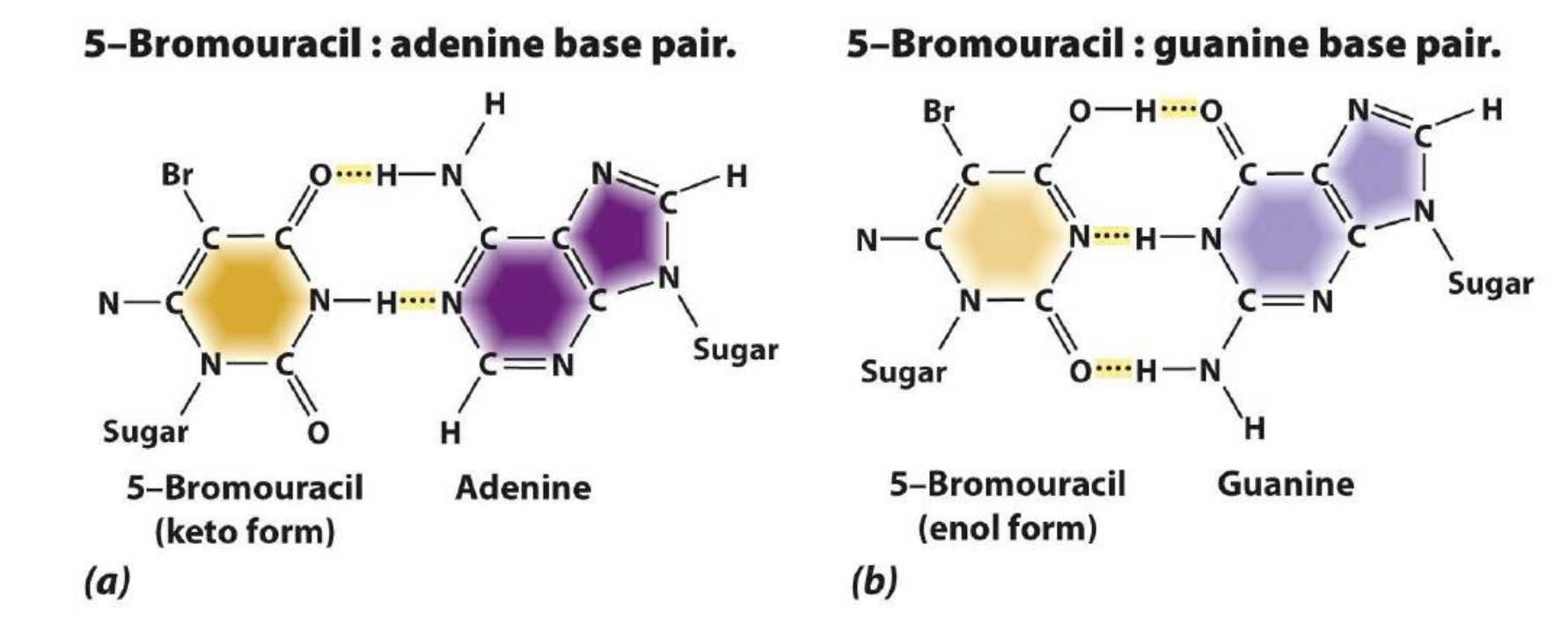

In this way, 5-bromouracil can promote a change of an AT base pair into a GC base pair
Physical Mutagens
Physical mutagens come into two main types
- Ionizing radiation
- Nonionizing radiation
(1) Ionizing radiation
- Includes X-rays and gamma rays
- Has short wavelength and high energy
- Can penetrate deeply into biological molecules
- Creates chemically reactive molecules termed free radicals
- Can cause
- Base deletions
- Oxidized bases
- Single nicks(裂纹) in DNA strands
- Cross-linking
- Chromosomal breaks
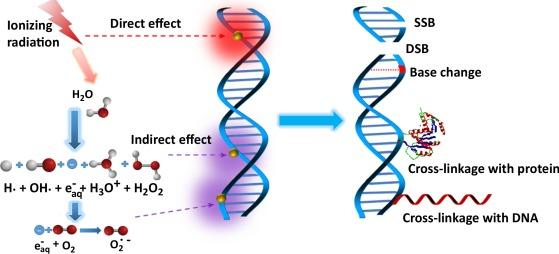
(2) Nonionizing radiation
Includes UV light
Has less energy
Cannot penetrate deeply into biological molecules
Causes the formation of cross-linked thymine dimers
Thymine dimers may cause mutations when that DNA strand is replicated
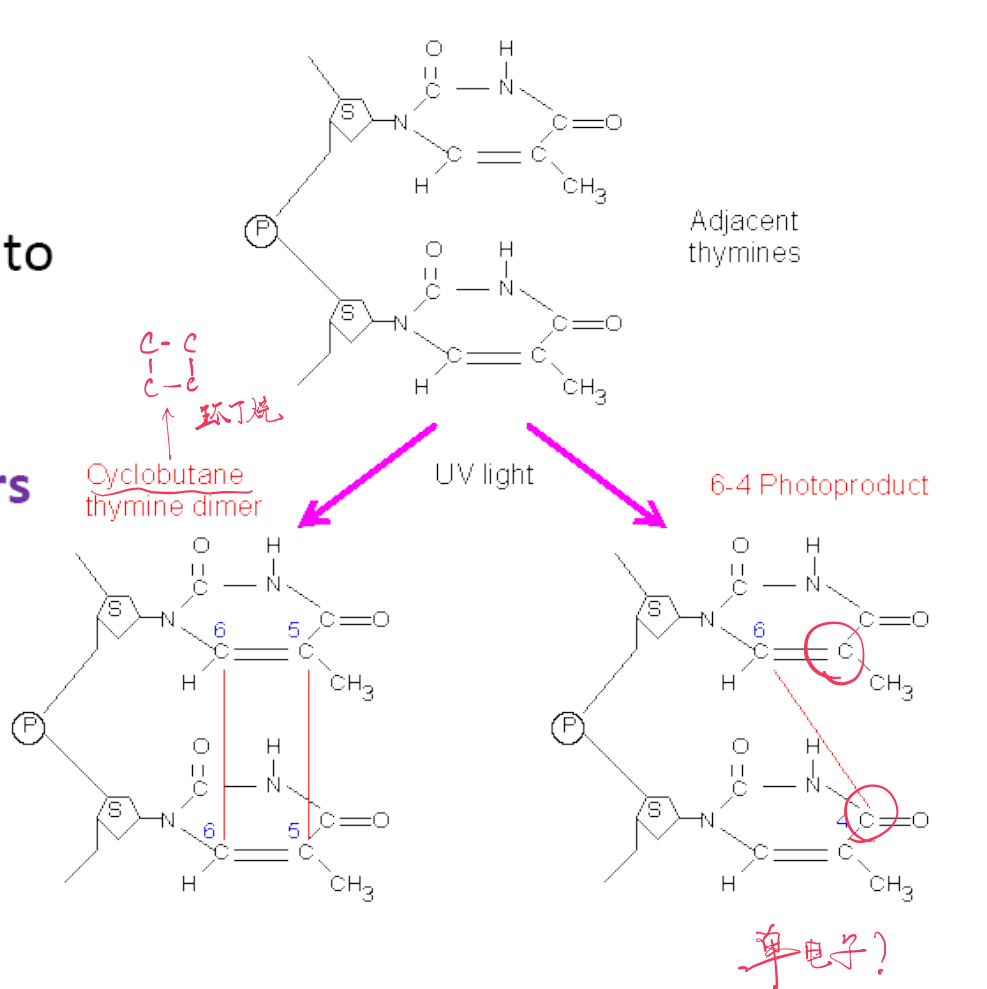
Tests for Mutagens
Many different kinds of tests have been used to evaluate mutagenicity
- One commonly used test is the Ames test(艾美氏试验)
- Developed by Bruce Ames
- The test uses a strain of Salmonella(沙门氏菌) typhimurium that cannot synthesize the amino acid histidine
- It has a point mutation in a gene involved in histidine biosynthesis
- A second mutation (i.e., a reversion) may occur restoring the ability to synthesize histidine
- The Ames test monitors the rate at which this second mutation occurs
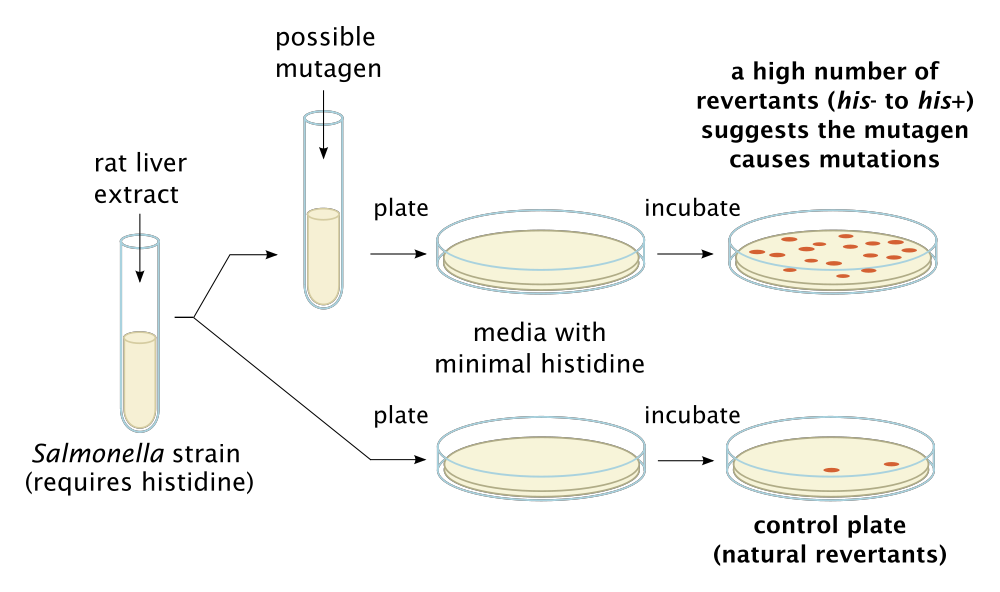
艾美氏试验(英语:Ames test,又称为细菌回复突变试验或安姆氏突变试验)为美国人布鲁斯·埃姆斯博士于1983年所提出的突变物测试方法。此法检测出175已知之致癌物,并发现其中有超过90%者皆显示为阳性(具突变性),因此,艾美氏试验也被做为先期测试方法之一。而现在正以艾美氏试验为模式系统,进行各式化学物可能的毒性及致突变性之安全评估,但仍需其它的测试辅助测试而进一步确认。
二、DNA Repair
Since most mutations are deleterious, DNA repair systems are vital to the survival of all organisms
- Living cells contain several DNA repair systems that can fix different type of DNA alterations
In most cases, DNA repair is a multi-step process
- An irregularity in DNA structure is detected
- The abnormal DNA is removed
- Normal DNA is synthesized
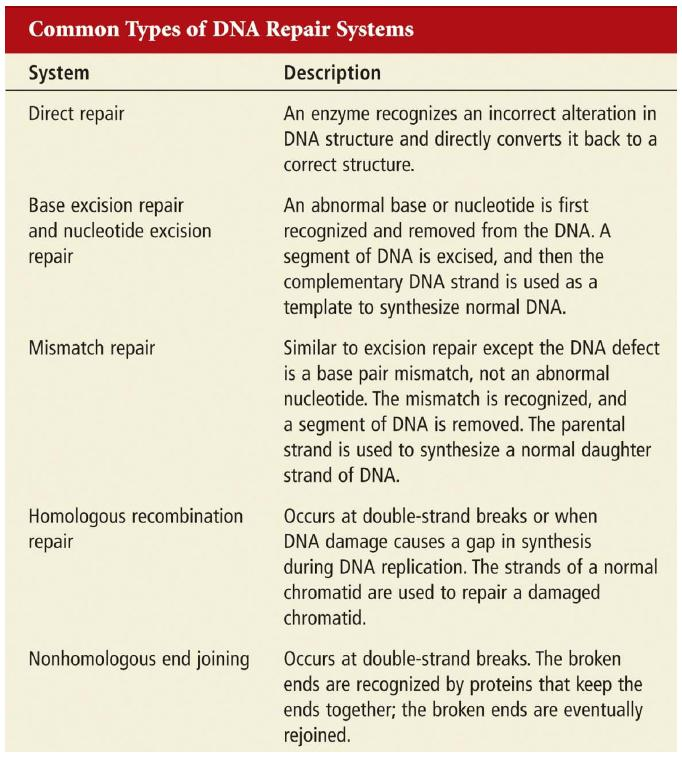
Directly Repaired
In a few cases, the covalent modifications of nucleotides can be reversed by specific enzymes
- Photolyase (光裂合酶) can repair thymine dimers
- It splits the dimers restoring the DNA to its original condition
- Uses energy of visible light
光裂合酶(Photolyases,EC 4.1.99.3)为一种DNA修复酵素,专门修复遭受紫外线破坏的DNA。此酵素的作用需要可见光的协助,最好是在蓝紫光下,此现象称为光致活作用(photoreactivation)。
由系统发生学来看,光裂合酶为一个相当古老的酵素,从细菌、真菌,到动物体内都有,在植物体内尤为重要。但人和其他胎盘哺乳类体内却改以另一种较无效率的核苷酸切除修复法来取代光裂合酶,因此并无此酵素活性。
在DNA中,相邻的胸腺嘧啶受到紫外线的照射时,会形成共价键,形成环丁烷桥,称为胸腺嘧啶二聚体,导致基因病变。光裂合酶会接在DNA上,切除胸腺嘧啶二聚体。
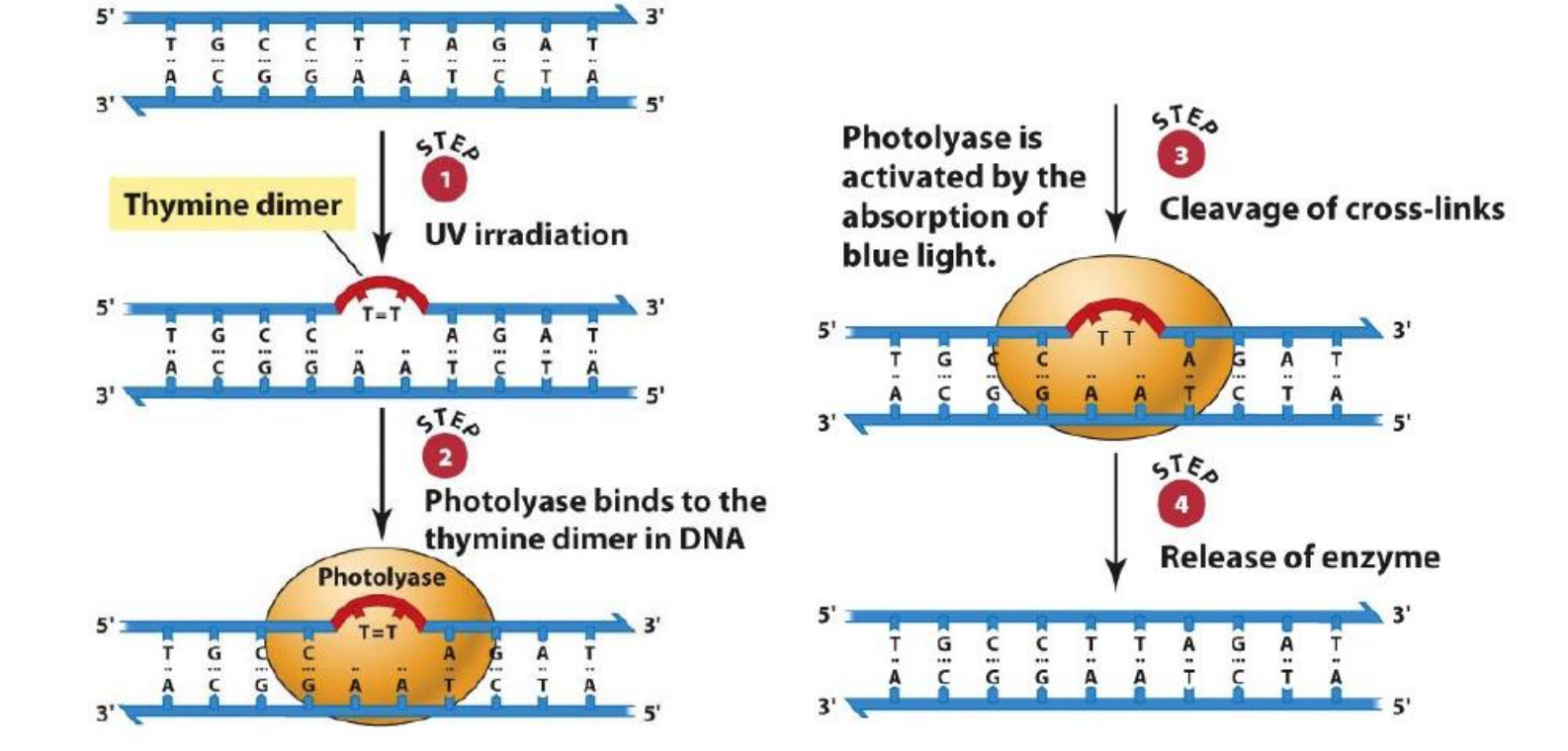
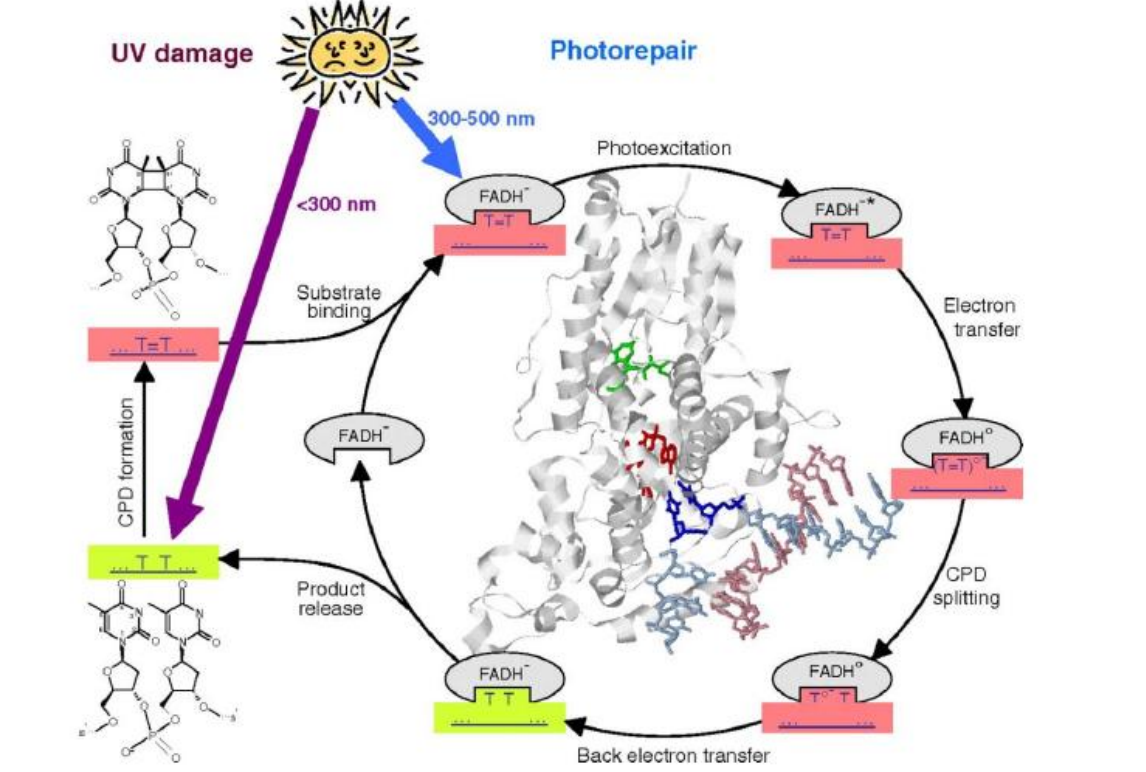
$O^{6}$-alkylguanine alkyltransferase repairs alkylated bases
It transfers the methyl or ethyl group from the base to a cysteine side chain within the alkyltransferase protein
- Surprisingly, this permanently inactivates alkyltransferase!
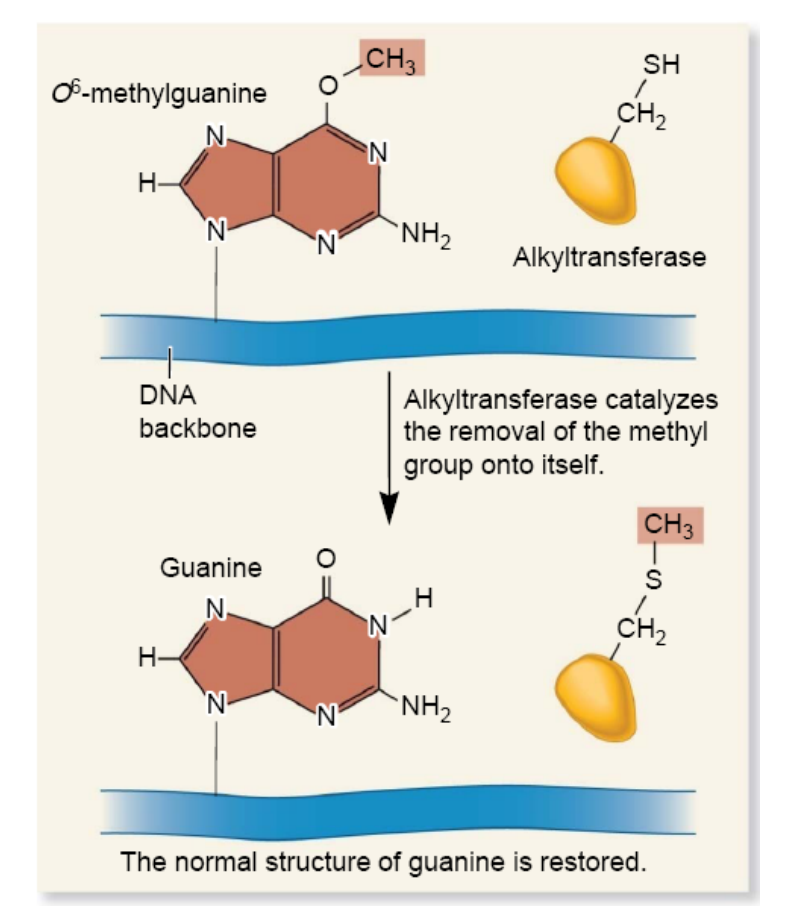
Base Excision Repair
Base excision repair (BER) involves a category of enzymes known as DNA N-glycosylases
- These enzymes can recognize an abnormal base and cleave the bond between it and the sugar in the DNA
Depending on the species, this repair system can eliminate abnormal bases such as
Uracil; Thymine dimers
3-methyladenine; 7-methylguanine
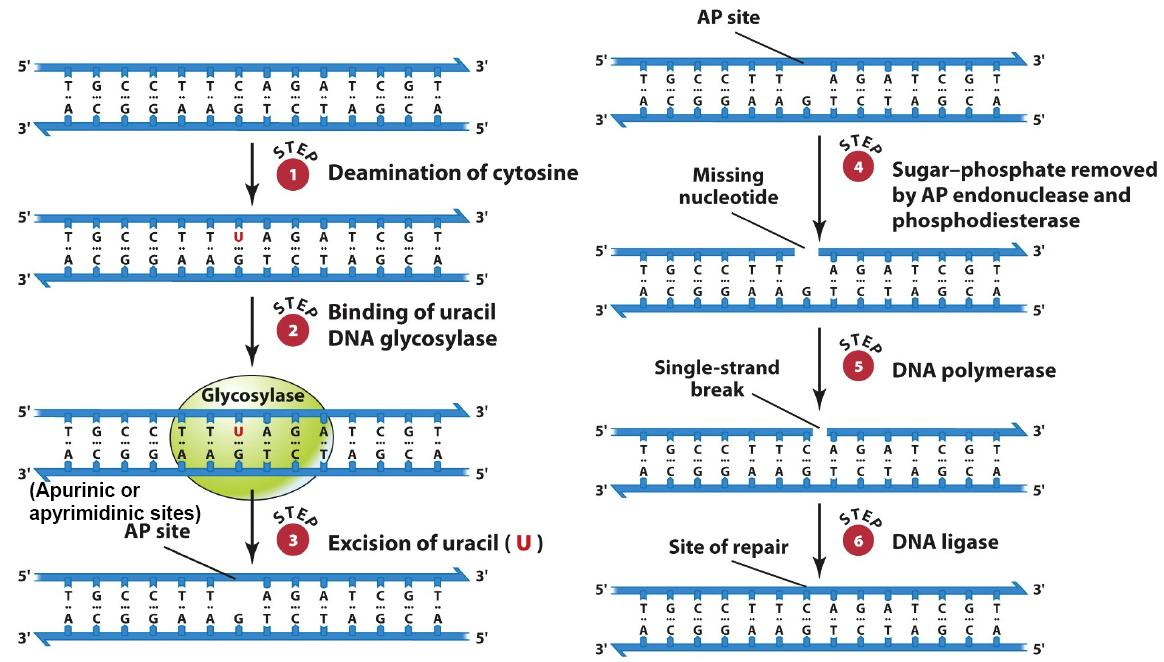
nucleotide excision repair (NER)
An important general process for DNA repair is nucleotide excision repair (NER)
This type of system can repair many types of DNA damage, including
Thymine dimers and chemically modified bases
missing bases, some types of crosslinks
NER is found in all eukaryotes and prokaryotes
- However; its molecular mechanism is better understood in prokaryotes
In E. coli, the NER system requires four key proteins
These are designated UvrA, UvrB, UvrC and UvrD
- Named as such because they are involved in IJItrayiolet light repair of pyrimidine dimers
- They are also important in repairing chemically damaged DNA
- Named as such because they are involved in IJItrayiolet light repair of pyrimidine dimers
UvrA, B, C, and D recognize and remove a short segment of damaged DNA
DNA polymerase and ligase finish the repair job
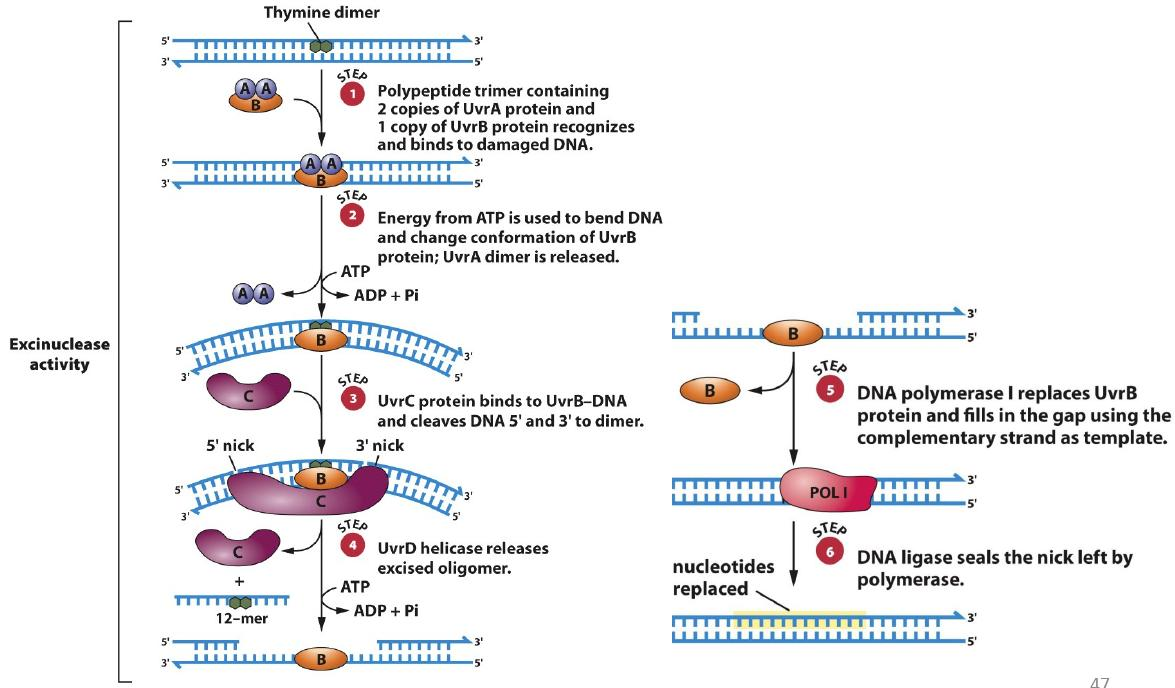
Mismatch Repair Systems Detect Correct A Base Pair Mismatch
A base mismatch is another type of abnormality in DNA
The structure of the DNA double helix obeys the AT/GC rule of base pairing
- However; during DNA replication an incorrect base may be added to the growing strand by mistake
DNA polymerases have a 3’ to 5’ proofreading ability that can detect base mismatches and fix them
If proofreading fails, the mismatch repair system comes to the rescue
Mismatch repair systems are found in all species
An important aspect of these systems is that they are specific to the newly made strand
The molecular mechanism of mismatch repair has been studied extensively in E. coli
- Three proteins, MutL, MutH and MutS detect the mismatch and direct its removal from the newly made strand
- The proteins are named Mut because their absence leads to a much higher mutation rate than normal
- A key characteristic of MutH is that it can distinguish between the parental strand and the daughter strand
- Prior to replication, both strands are methylated
- Immediately after replication, the parental strand is methylated whereas the daughter is not!
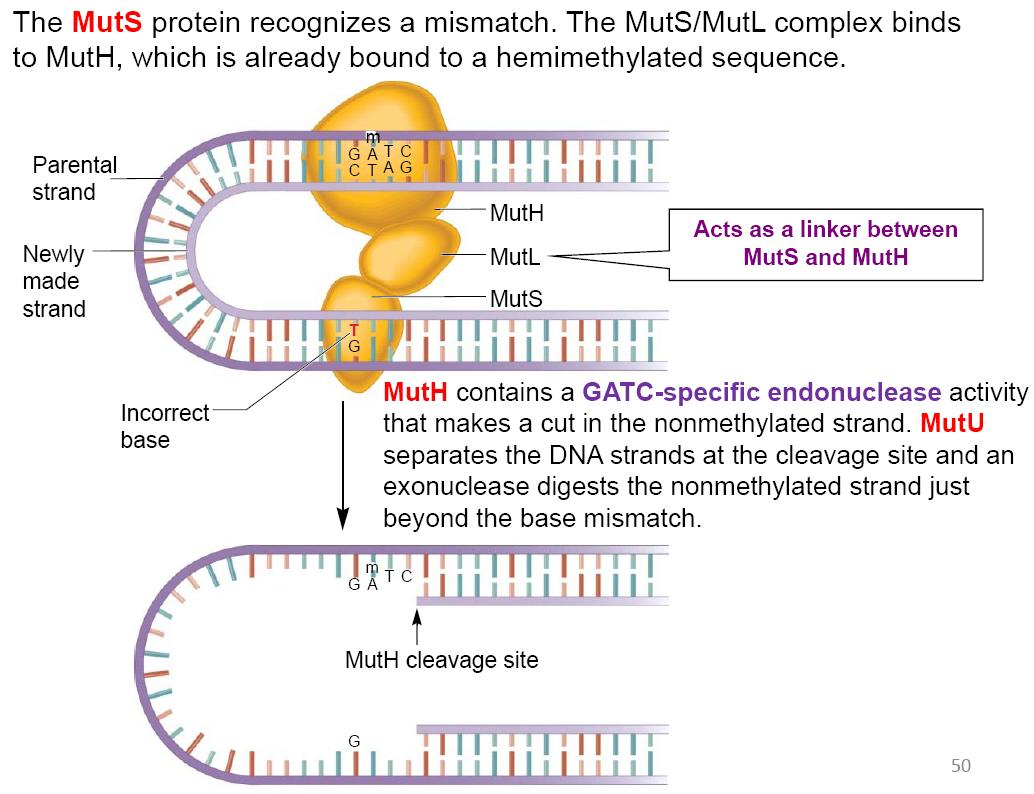
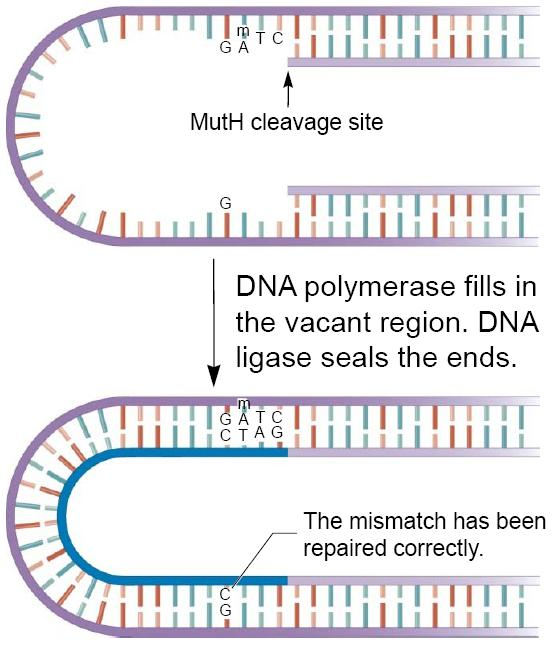
Recombination Repair
DNA Double-Strand Breaks are very dangerous
- Breakage of chromosomes into pieces
- Caused by ionizing radiation and chemical mutagens
- Also caused by reactive oxygen species which are the byproducts of cellular metabolism
- 10-100 breaks occur each day in a typical human cell
- Breaks can cause chromosomal rearrangements and deficiencies
- They may be repaired by two systems known as homologous recombination repair (HRR) and nonhomologous end joining (NHEJ)
1. homologous recombination repair 同源重组修复
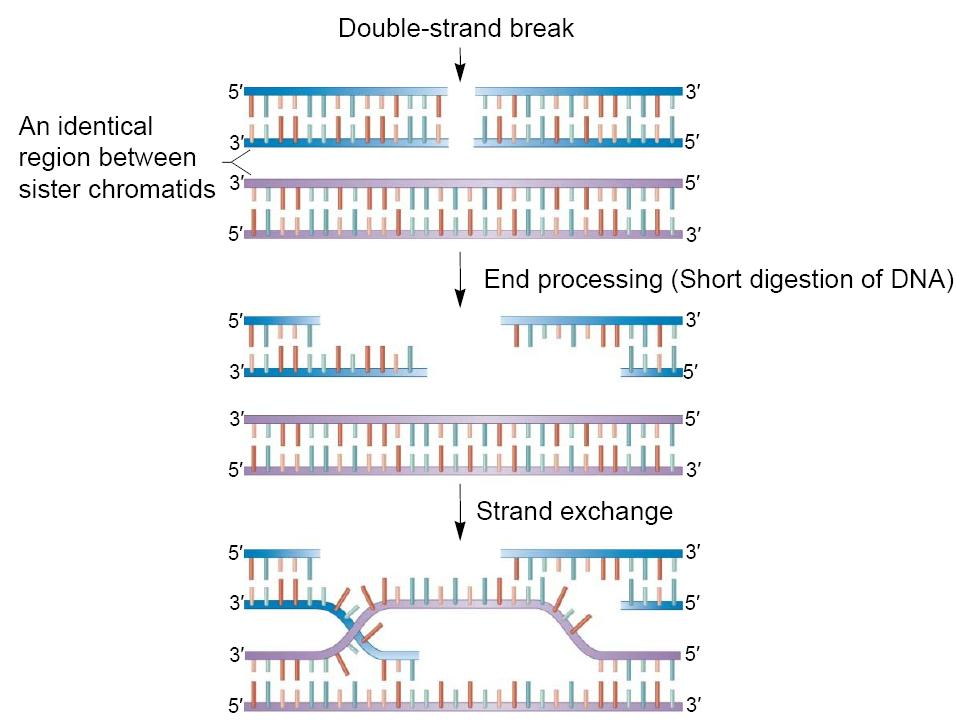
Advantage: Error-free
Disadvantage: Sister chromatids only available during S and G2 phases of the cell cycle in eukaryotes or following DNA replication in bacteria
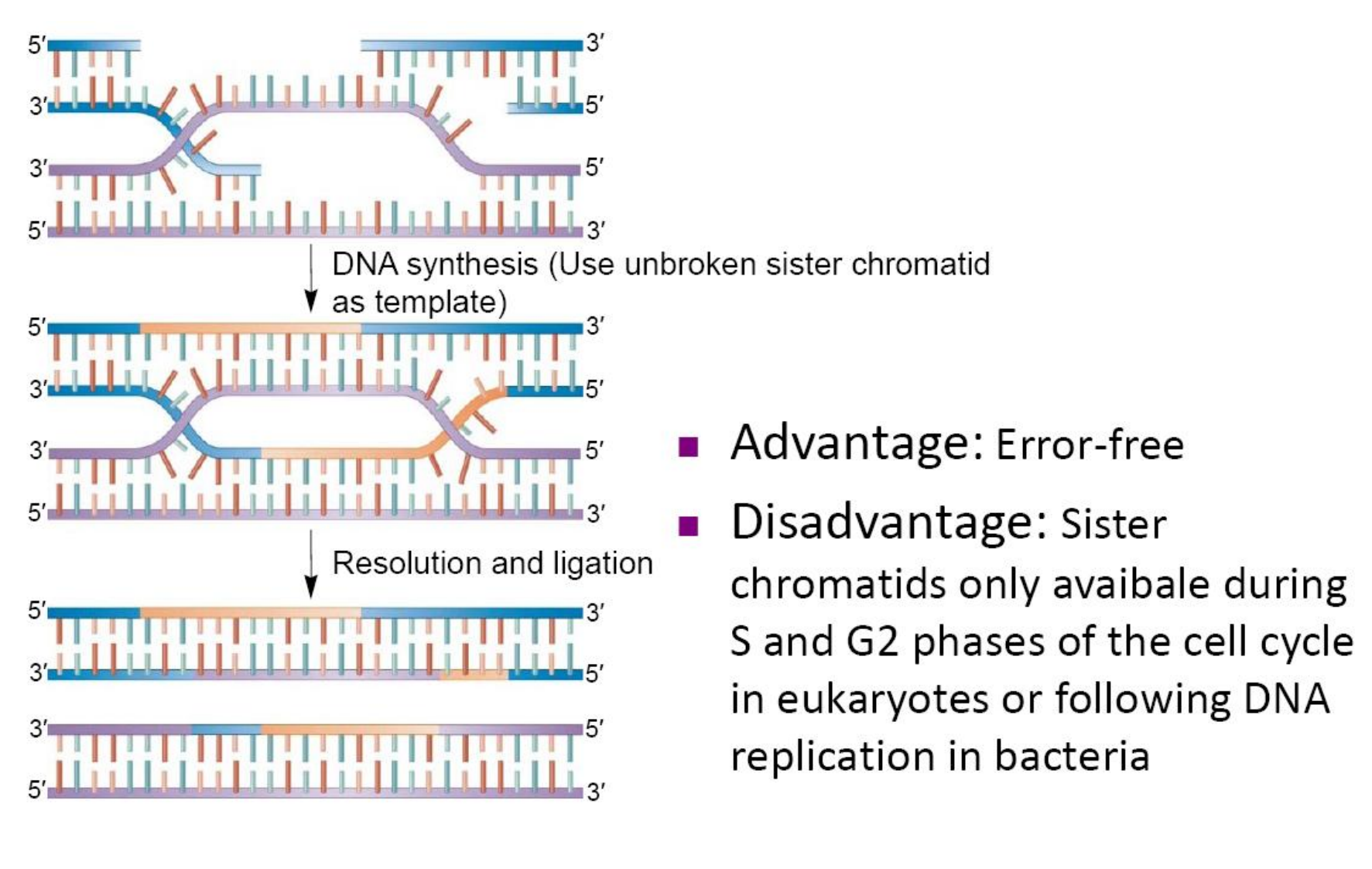
2. nonhomologous end joining 非同源端联接
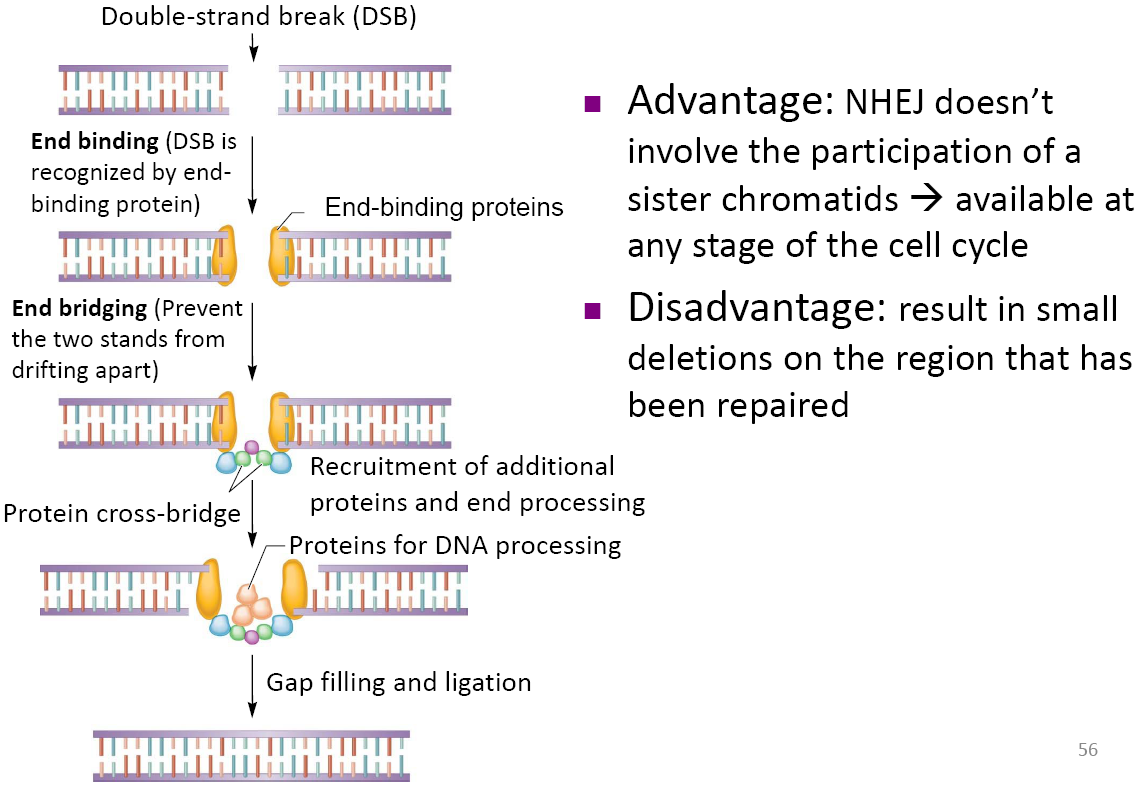 Advantage: NHEJ doesn’t involve the participation of a sister chromatids → available at any stage of the cell cycle
Advantage: NHEJ doesn’t involve the participation of a sister chromatids → available at any stage of the cell cycle
Disadvantage: result in small deletions on the region that has been repaired
Inherited Human Diseases with Defects in DNA Repair
